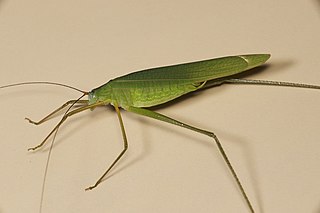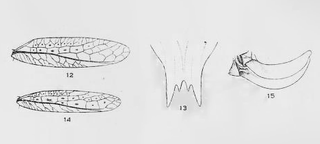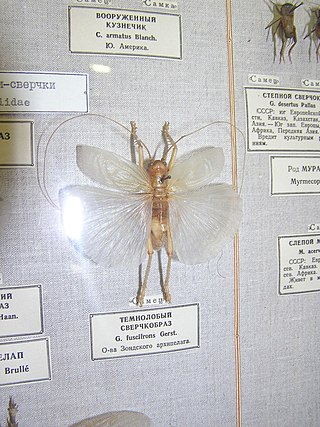
The Phaneropterinae, the sickle-bearing bush crickets or leaf katydids, are a subfamily of insects within the family Tettigoniidae. Nearly 2,060 species in 85 genera throughout the world are known. They are also known as false katydids or round-headed katydids.

Holochlora is a genus of bush-crickets in the subfamily Phaneropterinae. They occur in Africa and Asia.

Gryllacridinae is an Orthopteran subfamily in the family Gryllacrididae.

Larnaca is an Asian genus of Orthopterans, sometimes known as 'leaf-folding crickets', in the subfamily Gryllacridinae and tribe Gryllacridini. Species have been recorded from: southern China, Indochina and western Malesia.
Capnogryllacris is a genus of leaf-rolling crickets in the subfamily Gryllacridinae and tribe Capnogryllacridini. Species are found in Far East and South Asia, which includes those previously placed in the obsolete genus Borneogryllacris.
Himertula is a genus of bush crickets in the subfamily Phaneropterinae and tribe Letanini. Species can be found mostly in the Indian sub-continent.

Trigonidium is a large genus of sword-tail crickets, typical of the tribe Trigonidiini. Records of occurrence are from Europe, Africa, tropical Asia, Australia and the Pacific islands; many species endemic to Pacific islands including Hawaii have now been placed in the genus Nudilla.
Lipotactes is a genus of bush crickets found in southern China, Indo-China and Malesia; it is the only living genus in the subfamily Lipotactinae.

Elimaea is a large genus within Tettigoniidae, the bush cricket or katydid family. Species in this genus are found in India, southern China, Indo-China and Malesia.

Ducetia is the type genus of the Ducetiini: a tribe of bush crickets. The genus was erected by Carl Stål and species have a widespread distribution in Africa, Asia and Australia.
Isopsera is an Asian genus of bush crickets in the subfamily Phaneropterinae. Species can be found in India, Indochina, Malesia and the Pacific Islands.
Deflorita is a genus of Asian bush crickets of the tribe Mirolliini.
Hueikaeana is a genus of Asian bush crickets of the tribe Mirolliini within the subfamily Phaneropterinae.

Stictophaula is a genus of Asian Tettigoniidae of the tribe Holochlorini within the subfamily Phaneropterinae. They are found in Indo-China, China, and Malesia.
Anabropsis is a genus of king crickets in the tribe Anabropsini. They are found tropical areas of the Americas, Africa and Asia.
Rhaphidophora is the type genus of camel crickets in the tribe Rhaphidophorini.

Gryllacris is a genus of Orthopterans, sometimes known as 'leaf-folding crickets' in the family Gryllacridinae. It is the type genus for the family, tribe Gryllacridini and its subfamily.

Hyperbaeninae is a subfamily of Orthopterans, sometimes known as 'leaf-folding crickets' in the family Gryllacrididae; Hyperbaenus ensifer is the type species. The known distribution includes tropical: central and southern America, Africa and mainland Asia to Australasia.
Phryganogryllacris is an Asian genus of Orthopterans, sometimes known as 'leaf-folding crickets', in the subfamily Gryllacridinae and tribe Phryganogryllacridini. Species have been recorded from: India, China, Indochina, Malesia, through to New Guinea.
Neanias is a genus of Orthopterans, sometimes known as 'leaf-folding crickets' in the subfamily Gryllacridinae and tribe Gryllacridini. The recorded distribution is: Indian subcontinent, Japan, Hainan, Indochina, and western Malesia (Sumatra).









